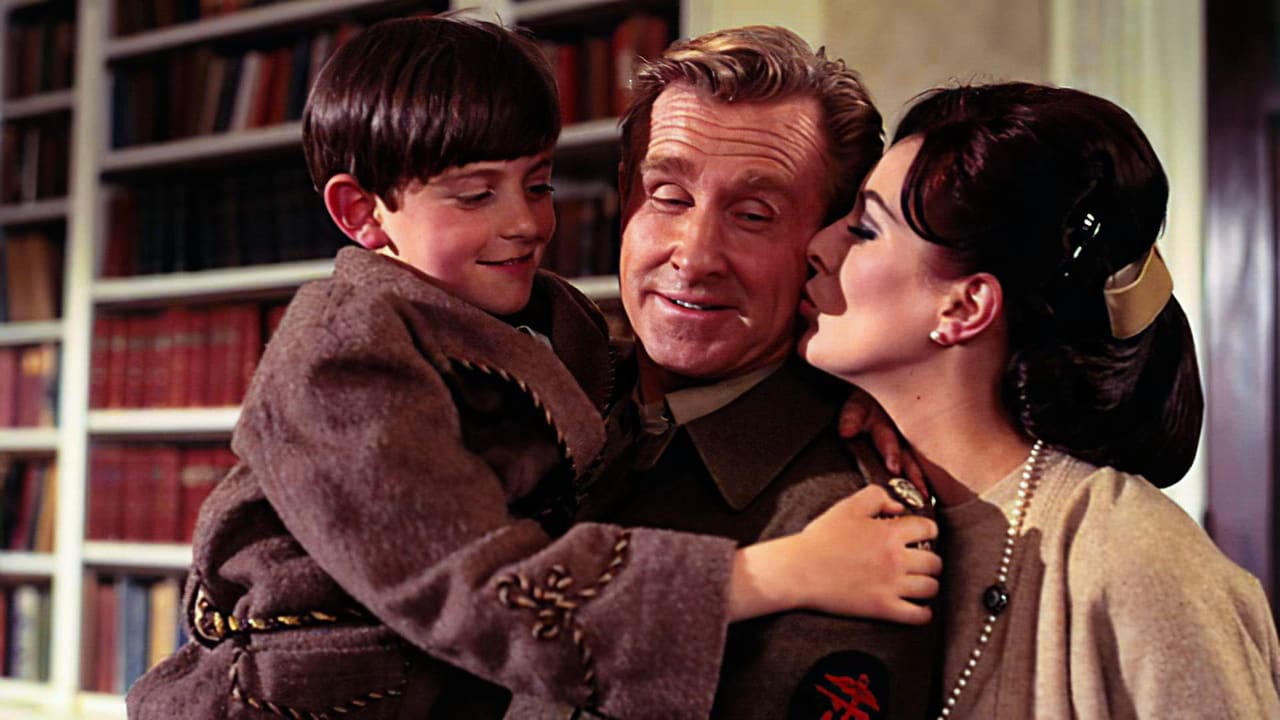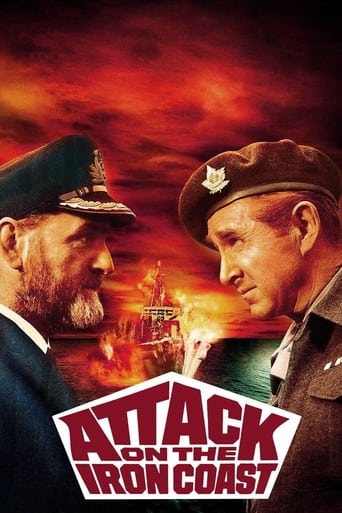



What a waste of my time!!!
Purely Joyful Movie!
Better Late Then Never
Great example of an old-fashioned, pure-at-heart escapist event movie that doesn't pretend to be anything that it's not and has boat loads of fun being its own ludicrous self.
View MoreStrangely inconsistent movie that was clearly done on a minuscule budget where accuracy and continuity mean little. Lloyd Bridges is not exactly renowned for his acting style - he's in it to help sell the movie in the US. The rest of the cast are all British stalwarts.Much of the fight scenes appear to have been filmed on derelict St Katherine's Dock of the late 60s before it was revamped to be one of the most desirable areas of London. Tower Bridge can be observed in the background in some shots. It also looks like the fight scenes were filmed in the same location or possibly around Pinewood Studios. The idea that the small St Katherine's dry dock could actually double up as dry dock for giant German battleships is quite ludicrous.I noticed also the cast making dialogue mistakes. British naval officers would always say "Left-tenant", even it's written as "Lieutenant".They also say they are leaving Portsmouth to carry out the raid but they pass through Tower Bridge and supporting shots look like the defunct docks where London City Airport is now.On the other hand some accuracy which could have been down to luck - one officer checks his watch and it's an Omega brand which is a Swiss manufacturer commonly supplying the UK military for many years.Overall the movie is one for collectors of the genre.
View MoreLloyd Bridges and Andrew Keir play WWII commando leaders who lead a group of soldiers on a suicide mission to destroy a Nazi naval stronghold on the French coast by means of a dead ship turned into a live bomb . As the valiant soldiers sailed it down the throat of the enemy . They carry out their risked assignment while keeping their activities hidden from outsiders and German airplanes . At the end , they arrive in the enemy port commanded by Nazi officers : Van Horst (Walter Gotell) and Captain Strasser (George Mikell) . The Germans had a number of reinforced submarine pens, but the target of the actual attack was the dry dock facilities . It was called ¨The St Nazaire Raid¨ or ¨Operation Chariot¨ that commenced on March 28th, 1942 , it was a successful British amphibious attack on the heavily defended Normandie dry dock at St Nazaire in German-occupied France during the Second World War.World War II war film loosely based on the Operation Chariot , an attack on the Iron coast in St Nazaire . It's a fictionalized recounting of the known mission on St Nazaire , here called LeClair (Ste-Nazaire) with a sustained and predictable story , although partially based on true deeds . Acceptable acting from Lloyd Bridges and Andrew Keir as two commanders who take on a strong battle of wits . The film progresses with Commander Major Jamie Wilson/Lloyd Bridges -takeoff on Lord Mountbatten- training the crews of the ships , even though the crew lacks faith in his command abilities . He must overcome tensions with his antagonist Captain Franklin/Andrew Keir . This and the 1952 film "Gift Horse" are based on the same World War Two raid carried out by British forces on the locks of the French port of St Nazaire in 1942 . The highlights of the movie are the violent as well as exciting fights of the crews who successfully fend off an final attack at St. Nazaire or LeClair . And thrilling scenes at the final when the ship penetrates the highly armored stronghold , nets in the port , and explosives blow up under the dry dock . It includes stock WWII , especially when show up some planes , the clips of the diversionary air raid were taken from the film The Dam Busters (1955) . Atmospheric cinematography by Paul Beeson , Walt Disney's usual cameraman, though an alright remastering is necessary . Being filmed on location , shooting was filmed in Gaddesden Place, Hemel Hempstead, Hertfordshire,Millwall Dock, Millwall, London, England, UK (French port of St. Nazaire) and St Katharine Docks, London, England, UK . Good and enjoyable musical score by Gerard Schurmann , though parts of Ron Goodwin's score from Squadron 633 (1964) were used without credit. The film was produced by Oakmont production , a company exclusively dedicated to warfare films (Submarine X1 , Hell boats , Mosquito Squadron , Thousand plane raid , Last escape) . The motion picture was professionally realized by Paul Wendkos who displays enough spectacular images to keep things interesting . Apparently, director worked on the film's original screen story with writer/producer John C. Champion but is uncredited for such . Wendkos whose works remain undervalued in USA directed various TV series and some films as ¨Guns of the Magnificent Seven¨ , ¨Cannon for Cordoba¨, ¨Gidget¨, ¨The Flight¨, ¨The legend of Lizzie Borden¨ and ¨Hell boats¨The film is based on real facts , these were the followings : The operation was undertaken by the Royal Navy and British Commandos under the auspices of Combined Operations Headquarters on 28 March 1942. The extra ships were along to transport all those who took part back to England after the operation. All of the 18 addition ships were sank during the attack. Other ships did accompany the attack but remained outside the area of the attack. In the actual operation the obsolete destroyer HMS Campbeltown was the lead ship in the attack. She was accompanied by 18 other smaller craft. St Nazaire was targeted because the loss of its dry dock would force any large German warship in need of repairs, such as the Tirpitz, to return to home waters via either the English Channel or the GIUK gap, both of which were heavily defended by British units including the Royal Navy's Home Fleet, rather than having a haven available on the Atlantic coast. The obsolete destroyer HMS Campbeltown, accompanied by 18 smaller craft, crossed the English Channel to the Atlantic coast of France and was rammed into the Normandie dock gates. The ship had been packed with delayed-action explosives, well hidden within a steel and concrete case, that detonated later that day, putting the dock out of service for the remainder of the war and up to five years after. A force of commandos landed to destroy machinery and other structures. Heavy German gunfire sank, set ablaze or immobilised virtually all the small craft intended to transport the commandos back to England ; the commandos had to fight their way out through the town to try to escape overland. Almost all were forced to surrender when their ammunition was expended and they were surrounded . After the raid 228 men of the force of 611 returned to Britain; 169 were killed and 215 became prisoners of war. German casualties were over 360 dead, some killed after the raid when Campbeltown exploded. To recognise their bravery, 89 decorations were awarded to members of the raiding party, including five Victoria Crosses. After the war, St Nazaire was one of 38 battle honours awarded to the Commandos; the operation has since become known as The Greatest Raid of All within military circles. The men who took part in this attack received more awards for bravery then any other operation of it's length then any other operation before or since.
View MoreThere's not much to say in favour of this movie, except maybe that it makes a brave effort with a weak script and a small budget. The plot is too simple and straightforward, there's absolutely no action until the final 15 minutes or so, naval and air force scenes are low-quality models, most the entire film is taken up with some rather hokey conflicts between characters, the music is often too overblown for the action. The Germans are completely inept; for a port that can service one of the largest warships in the German navy, it seems undermanned and disorganized. When the action does come, there seems no objective to any of it; soldiers from both sides are constantly popping up left and right from behind cover and mowing down a few enemies before being mowed down themselves. What was the plan of this operation, anyway? To drive a ship rigged with explosives into the port and blow up the facilities. Sure, that's clear enough. But what are all those soldiers doing running this way and that way, shooting in every possible direction with no discernible purpose to it? They seemed to be aiming at some objective or other - they did keep running, after all - but what were they trying to do besides kill whatever Germans they ran across? I had some hope for the movie, but it was worse than I anticipated. And by the way, was there any point in having Lloyd Bridges play a Canadian? His wife and son spoke with British accents. Was he made Canadian just so that dear old Lloyd wouldn't have to fake a British accent?
View MoreI just wanted to point out, that this movie is indeed based on an actual event, the raid on St. Nazaire. The former flush decked WWI Destroyer "Campbeltown" was converted to look like a german "E-Boat" and was loaded with explosives, and rammed into the "Normandie" dry dock. The operation was code named "Operation Chariot", and commenced on March 28th, 1942.
View More